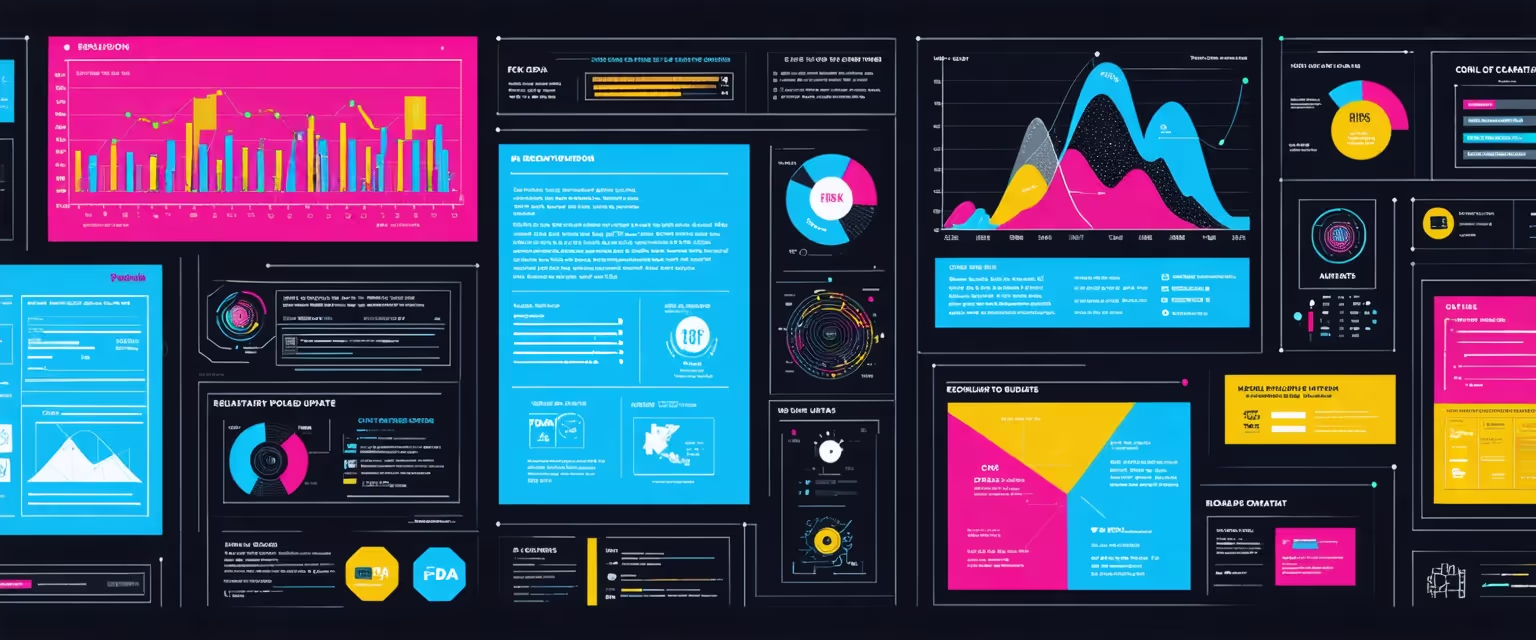Discover how AI streamlines regulatory change monitoring, turning chaos into a compliance asset for healthcare directors. Stay proactive with Datagrid's solutions.
Healthcare compliance directors face constant pressure to stay ahead of evolving regulations. Manually tracking updates across fragmented sources is time-consuming and error-prone, increasing the risk of costly oversights.
Thanks to advancements in Agentic AI, it is now possible to monitor regulatory changes in real time, flagging relevant updates before they impact operations.
Datagrid's AI agents automate this monitoring process, reducing manual effort and helping teams respond to change with confidence.
This article explains how AI agents automate regulatory change tracking for healthcare compliance directors.
What is Regulatory Change Monitoring in Healthcare Compliance?
Regulatory change monitoring in healthcare compliance is the continuous, systematic process of tracking, interpreting, and implementing updates in healthcare laws, standards, and mandates across jurisdictions.
This function involves scanning multiple sources, from HHS and CMS to FDA databases and state licensing boards, to identify new requirements and policy modifications that could impact your organization.
Healthcare regulatory landscapes shift constantly, with frequent updates spanning data privacy, patient safety, reimbursement models, and cybersecurity standards.
You're navigating requirements from multiple bodies at national, state, and sometimes municipal levels, creating a fragmented compliance environment that demands precision.
The scope encompasses comprehensive policy review, risk assessment, documentation updates, staff training modifications, and audit preparation.
Effective monitoring ensures you stay ahead of evolving regulatory requirements while maintaining operational efficiency and avoiding costly penalties that could disrupt patient care.
The Role of Regulatory Change Monitoring in Ensuring Healthcare Compliance
As a compliance director, you're not just checking boxes, you're the guardian of your organization's reputation and financial health. Patient safety, data privacy, and organizational integrity depend on your ability to navigate an increasingly complex regulatory maze.
The stakes have never been higher. Research shows that many health plans now prioritize compliance strategies, reflecting the real cost of failures. This directly addresses a painful truth: more than half of compliance leaders can't find enough resources to handle evolving security and regulatory risks.
Poor regulatory monitoring opens your organization to HIPAA violations, FDA enforcement actions, and state healthcare penalties. The fallout goes far beyond fines, you risk operational shutdowns, compromised patient data, and shattered trust.
Your responsibility covers everything from how patient data moves through your systems to pharmaceutical handling.
Simply put, effective regulatory monitoring determines whether your organization thrives or becomes another compliance casualty.
Traditional Processes Slowing Down Regulatory Change Monitoring
Healthcare compliance directors juggle tracking regulatory changes across multiple jurisdictions while keeping daily operations running smoothly. Traditional monitoring methods simply can't keep pace with constant shifts happening at federal, state, and local levels.
Manual Scanning of Regulatory Updates
Your compliance teams burn hours each week hunting updates from CMS, FDA, and state health departments. Each source publishes in different formats and timelines, creating a monitoring nightmare.
Teams visit dozens of websites, wade through multiple newsletters, and review dense regulatory bulletins trying to catch everything. This scattered approach creates dangerous delays and increases the odds of missing critical changes that impact compliance status.
Interpreting Complex Legal Texts
Have you tried reading regulatory language? Dense legalese requires specialized expertise to understand what actually applies to your operations. Even veteran compliance professionals need legal consultations to decipher new requirements, creating bottlenecks that delay implementation.
Just interpreting one regulatory change can take days or weeks—now multiply that across dozens of annual updates.
Cross-Referencing Across Policies and Frameworks
Each new regulation must be compared against your existing policies, risk controls, and documentation. This gets exponentially complex in organizations answering to multiple regulatory bodies.
Teams waste valuable time mapping new requirements to current procedures, spotting conflicts, and figuring out which internal policies need updates.
Manual cross-referencing creates a slow, error-prone process that becomes more unmanageable as your organization grows.
Maintaining Documentation for Compliance Reviews
Compliance demands meticulous documentation of every change, creating endless manual work to maintain version control and prepare audit trails. Your teams must document what changed, when, why, and how it was implemented.
This documentation burden often takes more time than actual implementation, yet remains essential for proving regulatory adherence during audits.
Delays in Updating Staff Training Materials
Training content lags behind regulatory changes. Manual updating of training materials, scheduling sessions, and ensuring everyone understands the changes creates dangerous gaps where staff operate under outdated procedures.
For example, AI can automate and personalize toolbox talk content, ensuring staff receive timely and relevant training updates.
Limited Bandwidth for Forward-Looking Compliance Strategy
Traditional methods trap your teams in reactive mode, consuming so much time tracking and implementing current changes that strategic planning suffers. Instead of anticipating future regulatory trends or assessing long-term compliance risks, your resources remain focused on catching up with existing requirements.
This reactive approach leaves your organization vulnerable, missing opportunities for proactive risk mitigation and strategic compliance positioning.
How AI Agents Automate Regulatory Change Monitoring
AI agents turn manual, reactive regulatory monitoring into intelligent, proactive systems that handle the complex task of tracking updates across multiple jurisdictions simultaneously.
These tools use natural language processing and machine learning to operate autonomously, monitoring, analyzing, and responding to regulatory changes in real-time without constant human oversight.
Continuous Monitoring of Regulatory Sources
AI agents scan regulatory websites, government bulletins, and legal databases 24/7 without taking breaks. Unlike manual tracking that depends on staff availability, these systems provide round-the-clock surveillance of hundreds of data sources at once.
They monitor federal agencies like CMS and FDA, state health departments, international regulatory bodies, and industry publications. This vigilance eliminates the risk of missing critical updates during nights, weekends, or staff vacations.
In addition to official sources, AI can also automate social media monitoring, capturing relevant regulatory discussions and emerging trends.
Real-Time Alerts for Relevant Changes
Advanced filtering delivers targeted notifications based on your specific regulatory environment. AI agents process massive datasets to identify patterns and updates that directly impact your operations, filtering out irrelevant noise.
You receive immediate alerts only for changes affecting your jurisdiction, facility type, or service offerings, cutting through information overload while ensuring complete coverage. Additionally, AI can automate the creation of newsletters summarizing these updates for your team.
Natural Language Processing for Policy Interpretation
AI-powered natural language processing decodes dense legal terminology into clear, actionable insights your team can implement right away. These systems analyze and summarize regulatory changes, translating complicated policy language into specific requirements and deadlines that fit your operational workflows.
This removes the bottleneck of extensive legal review for every update. Moreover, AI can also optimize email outreach to efficiently disseminate these insights to your team.
Automated Mapping to Internal Controls
AI agents connect new regulatory requirements with your existing policies, procedures, and control frameworks automatically. They identify which internal documents need updates and highlight potential compliance gaps before they become violations.
This automated cross-referencing saves hours of manual analysis while ensuring nothing falls through the cracks. Similar technologies can automate finance compliance monitoring, ensuring financial regulations are met with precision.
Audit-Ready Documentation and Change Logs
Every regulatory review and organizational response gets automatically documented with timestamps, version controls, and audit trails. AI systems create comprehensive records of compliance activities, tracking what changes were identified, when they were implemented, and who handled each action.
This automated documentation streamlines audit preparation and demonstrates regulatory diligence without additional manual effort.
Virtual Assistants for Compliance Support
AI-powered virtual assistants provide immediate support to your staff, answering questions about regulatory requirements and guiding teams through implementation.
These systems reduce reliance on compliance officers for routine guidance while ensuring consistent interpretation and application of requirements across your organization.
Datagrid for Healthcare Professionals
Healthcare professionals drown in patient data, compliance requirements, and administrative tasks daily. Datagrid's AI-powered platform turns these challenges into opportunities for better patient care and smoother operations.
Medical Documentation Documentation
Medical documentation becomes painless when you can process thousands of patient records, histories, and clinical notes simultaneously. The platform extracts critical patient information, spots patterns, and organizes data for quick access and analysis.
By streamlining scanned document extraction, AI enhances the accuracy and efficiency of medical documentation processes. Healthcare facilities using this technology report major reductions in administrative costs through fewer errors and faster processing.
Insurance Claim Processing
Insurance claim processing speeds up dramatically through automated review systems that validate coding, catch documentation gaps, and accelerate reimbursement.
AI-powered automation categorizes claims, bills, and remittance reports using deep learning models, ensuring accurate data management without traditional bottlenecks.
Treatment Protocol Analysis
Treatment protocol analysis compares patient cases against evidence-based guidelines to support medical decisions.
The system identifies optimal care paths by analyzing clinical data and recommending personalized treatment based on patient history, current symptoms, and established medical standards.
Medication Management
Medication management prevents adverse events by tracking prescription patterns, potential drug interactions, and adherence trends across your patients.
Real-time analysis flags high-risk situations for intervention, ensuring patients receive appropriate medications while reducing liability.
Regulatory Compliance Support
Regulatory compliance support keeps you ahead of HIPAA, GDPR, and other healthcare regulations through continuous auditing of documentation practices.
The system spots compliance risks before they become problems, while automated logging creates detailed audit trails of all document access and changes.
Real-time encryption and automatic security protocols maintain regulatory standards throughout.
Population Health Insights
Population health insights emerge from analyzing demographics, health outcomes, and social determinants across your patients.
This intelligence drives targeted preventive care and improves community health by identifying trends that inform public health strategies and resource decisions.
Clinical Research Support
Clinical research support accelerates initiatives by extracting and organizing relevant data from medical literature, clinical trials, and patient databases.
The platform identifies potential research participants and outcome patterns, streamlining research while highlighting promising areas for investigation.
Datagrid processes both structured and unstructured data so your clinical team can focus on patient care while the platform handles data-intensive tasks. The result? Enhanced efficiency that lets you focus on what truly matters—exceptional patient care.
Simplify Healthcare Tasks with Datagrid's Agentic AI
Don't let data complexity slow down your team. Datagrid's AI-powered platform is designed specifically for teams who want to:
- Automate tedious data tasks
- Reduce manual processing time
- Gain actionable insights instantly
- Improve team productivity
See how Datagrid can help you increase process efficiency.










